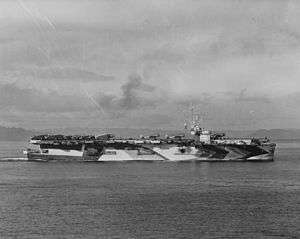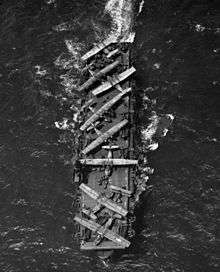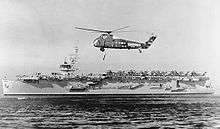Casablanca-class escort carrier
.jpg) USS Guadalcanal, 1944 | |
| Class overview | |
|---|---|
| Name: | Casablanca class |
| Preceded by: | Sangamon class |
| Succeeded by: | Commencement Bay class |
| Planned: | 50 |
| Completed: | 50 |
| Lost: | 5 |
| Retired: | 45 |
| General characteristics | |
| Type: | Escort carrier |
| Displacement: |
|
| Length: | 512.3 ft (156.1 m) overall |
| Beam: |
|
| Draft: | 22.5 ft (6.9 m) |
| Propulsion: |
|
| Speed: | 20 knots (37 km/h) |
| Range: | 10,240 nmi (18,960 km; 11,780 mi) at 15 knots (28 km/h; 17 mph) |
| Complement: |
|
| Armament: |
|
| Aircraft carried: | 28 |
The Casablanca-class escort aircraft carriers are the most numerous class of aircraft carriers ever built. Fifty were laid down, launched and commissioned within the space of less than two years – 3 November 1942 through to 8 July 1944. These were nearly one third of the 151 carriers built in the United States during the war. Despite their numbers, and the preservation of more famous and larger carriers as museums, none of these modest ships survive today. Five were lost to enemy action during World War II and the remainder were scrapped.
The first class to be designed from keel up as an escort carrier, the Casablanca class had a larger and more useful hangar deck than previous conversions. It also had a larger flight deck than the Bogue class. Unlike larger carriers which had extensive armor, protection was limited to splinter plating. Their small size made them useful for transporting assembled aircraft of various sizes, but fighters were limited to smaller and lighter aircraft such as the Grumman F4F Wildcat. The hull numbers were assigned consecutively, from CVE-55 Casablanca to CVE-104 Munda.
Casablanca-class carriers were built by Kaiser Company, Inc.'s Shipbuilding Division, Vancouver Yard on the Columbia River in Vancouver, Washington. The Vancouver yard was expressly built in 1942 to construct Liberty Ships, but exigencies of war soon saw the yard building LST landing craft and then escort carriers all before the end of the yard's first year in operation. The yard had twelve building ways and an enormous 3,000 foot outfitting dock along with a unique additional building slip originally intended to add prefabricated superstructures to Liberty ships. Their relatively small size and mass-production origins led their crews to refer to them as "jeep carriers" or "Kaiser Jeeps" with varying degrees of affection.
The Casablanca-class initially continued the US Navy's policy of naming escort carriers after bays and sounds, though several carried on the US Navy's tradition of naming aircraft carriers after battles. Those ships that appear to be named after islands, seas, straits or cities actually commemorated battles fought at those locations. Several had their original "Bay" names changed to battle names while under construction, and two of them (Midway and Coral Sea) lost their battle names mid-career to new Midway-class carriers, becoming USS St. Lo and USS Anzio respectively. Unlike the larger Essex and Independence-class carriers none were named to commemorate historical naval vessels.
Production time and Navy refusal
Although Essex-class aircraft carriers were completed in 20 months or less, 1941 projections on the basis of the 38-month average pre-war construction period estimated no new fleet carriers could be expected until 1944.[1] Kaiser had reduced construction time of cargo ships (Liberty ships) from more than a year to less than 90 days, and proposed building a fleet of 50 small carriers in less than two years. The US naval authorities refused to approve construction of the Kaiser-built ships until Kaiser went directly to the President's advisors. The Allies were in desperate need of carriers to replace early war losses. Kaiser produced the small carriers as rapidly as planned and resistance to their value quickly disappeared as they proved their usefulness defending convoys, providing air support for amphibious operations, and allowing fleet carriers to focus on offensive air-strike missions.
Service

_under_fire_at_Samar_1944.jpeg)

_underway_1944.jpg)
Although designated as convoy escort carriers, the Casablanca class was far more frequently used in large fleet amphibious operations, where speed was less important and their small airgroups could combine to provide the effectiveness of a much larger ship. Their finest hour came in the Battle off Samar, when Taffy 3, a task unit composed of six of these ships and their screen of three destroyers and four destroyer escorts gave battle against the Japanese main force. Their desperate defense not only preserved most of their own ships, but succeeded in turning back the massive force with only aircraft machine guns, torpedoes, depth charges, high-explosive bombs, and their own 5"/38 caliber guns. Tasked with ground support and antisubmarine patrols, they lacked the torpedoes and armor-piercing bombs to tackle a surface fleet alone. Taffy 3 was to be protected by Admiral Halsey's Third Fleet with carriers and battleships. But the Third Fleet had left the scene to pursue a decoy carrier fleet, inadvertently leaving Taffy 3 the only force between the massive Japanese fleet and undefended landing forces at Leyte Gulf. The lightly armed vessels each had only one 5-inch/38 cal gun mounted aft, yet two of their number, St. Lo (ex-Midway) and Kalinin Bay, became the only US aircraft carriers to ever record a hit on an enemy warship by its own guns. St. Lo hit a Japanese destroyer with a single round and Kalinin Bay damaged a Myōkō-class cruiser with two hits. Recent evidence suggests that six 5-inch shells fired from USS White Plains struck the cruiser Chōkai. One of theses rounds was reported to have impacted amidships on the starboard side, causing a large secondary explosion (probably from one of the Chōkai's own torpedoes) that proved fatal to the heavy cruiser. The White Plains gun crew claimed to have put all six 5-inch rounds into Chōkai from a range of 11,700 yards (10,700 m), near the maximum effective range for the 5-inch/38 gun. However, this claim is not supported by Japanese sources, which report this damage as resulting from an air attack.
Another noteworthy achievement of the Casablanca class was when USS Guadalcanal under command of Captain Daniel V. Gallery, participated in the first capture-at-sea of a foreign warship by the US Navy since the War of 1812 when a crew of volunteers from USS Pillsbury boarded German submarine U-505 after Gallery's Guadalcanal-centered hunter-killer group forced it to the surface with depth charges. Guadalcanal also earned the distinction of being the only aircraft carrier in history to conduct flight operations with a captured enemy vessel in tow.
Of the eleven United States aircraft carriers of all types lost during World War II, six were escort carriers, five of which were of the Kaiser-built Casablanca class:
- CVE-56 Liscome Bay
Sunk 24 November 1943. Submarine torpedo launched from IJN I-175 SW off Butaritari (Makin).
- CVE-73 Gambier Bay
Sunk 25 October 1944. Concentrated surface gunfire from IJN Center Force during Battle off Samar.
- CVE-63 St. Lo (ex-Midway)
Sunk 25 October 1944. Kamikaze aerial attack during Battle of Leyte Gulf.
- CVE-79 Ommaney Bay
Sunk 4 January 1945. Kamikaze aerial attack in the Sulu Sea en route to Lingayen Gulf.
- CVE-95 Bismarck Sea
Sunk 21 February 1945. Kamikaze aerial attack off Iwo Jima.

Unlike most other warships since HMS Dreadnought, the Casablanca-class ships were equipped with uniflow reciprocating engines instead of turbine engines. This was done because of bottlenecks in the gear-cutting industry, but greatly limited their usefulness after the war. Some ships were retained postwar as aircraft transports, where their lack of speed was not a major drawback. Some units were reactivated as helicopter escort carriers (CVHE and T-CVHE) or utility carriers (CVU and T-CVU) after the war, but most were deactivated and placed in reserve once the war ended, stricken in 1958-9 and scrapped in 1959-61. One ship, USS Thetis Bay, was heavily modified into an amphibious assault ship (LPH-6), but was scrapped in 1964.
Originally, half of their number were to be transferred to the Royal Navy under Lend-Lease, but instead they were retained in the US Navy and the Batch II Bogue-class escort carriers were transferred instead as the Ruler class (the RN's Batch I Bogues were the Attacker class).
Ships in class
See also
| Wikimedia Commons has media related to Casablanca class aircraft carriers. |
- List of ships of the Second World War
- List of ship classes of the Second World War
- List of aircraft carriers
References
pps. 1 & 2 - "Kaiser Company, Inc. - Vancouver", BuShips QQ files, NARA, College Park, MD.
- "The Ships We Build", Kaiser Company, Inc., n.d., c. immediate post-war, 1945.
- ↑ Friedman, Norman U.S. Aircraft Carriers United States Naval Institute (1983) ISBN 0-87021-739-9 pp.412&413
External links
- The Battle Off Samar – Taffy III at Leyte Gulf website by Robert Jon Cox